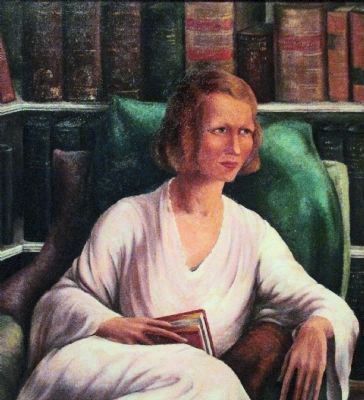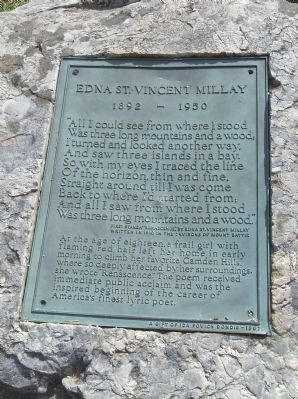Camden in Knox County, Maine — The American Northeast (New England)
Edna St. Vincent Millay
1892 — 1950
Was three long mountains and a wood;
I turned and looked another way,
And saw three islands in a bay.
So with my eyes I traced the line
Of the horizon, thin and fine,
Straight around till I was come
Back to where I’d started from;
And all I saw from where I stood
Was three long mountains and a wood.”
— First stanza “Renascence,” by Edna St. Vincent Millay written in 1910 in the environs of Mount Battie
At the age of eighteen, a frail girl with flaming red hair left her home in early morning to climb her favorite Camden Hills, where so deeply affected by her surroundings, she wrote “Renascence.” The poem received immediate public acclaim and was the inspired beginning of the career of America’s finest lyric poet.
Erected 1967 by a gift of Ida Povich Dondis.
Topics. This historical marker is listed in these topic lists: Arts, Letters, Music • Women. A significant historical year for this entry is 1910.
Location. 44° 13.366′ N, 69° 4.156′ W. Marker is in Camden, Maine, in Knox County. Marker can be reached from Mount Battie Road. Marker is on the summit of Mount Battie near the high end of Mount Battie Road, on a large rock beside the memorial lookout tower. Touch for map. Marker is in this post office area: Camden ME 04843, United States of America. Touch for directions.
Other nearby markers. At least 8 other markers are within 5 miles of this marker, measured as the crow flies. Mount Battie Memorial Tower (here, next to this marker); Spanish-American War Memorial (approx. 0.8 miles away); Civil War Memorial (approx. 0.8 miles away); The Schooner Grace Bailey / The Schooner Mercantile (approx. 0.9 miles away); William Conway (approx. one mile away); The Rockport Lime Kilns (approx. 2½ miles away); André the Seal (approx. 2½ miles away); French's Beach (approx. 5 miles away). Touch for a list and map of all markers in Camden.
Also see . . . Wikipedia entry for Edna St. Vincent Millay. (Submitted on September 8, 2010, by Roger W. Sinnott of Chelmsford, Massachusetts.)

Photographed By Allen C. Browne, November 2, 2011
4. Edna St. Vincent Millay
This 1934 portrait by Charles Ellis hangs in the National Portrait Gallery in Washington, DC.
“Literarily and temperamentally precocious, the poet Edna St. Vincent Millay exemplified the spirit of the ‘Roaring Twenties’ and the emancipation of American Women. She started writing as a child an became a rebellious student at Vassar College. In 1917 she move to Greenwich Village, the center of avant-garde and rebel culture. She won the Pulitzer Prize for The Harp-Weaver in 1923. Poetically, Millay was a romantic, inspired by the ecstatic visions of John Keats and William Wordsworth; he first notable poem ‘Renascence’ (1912) spoke of nature that ‘breathed my soul back into me.’ Her famous quatrain ‘First Fig’ (1920) celebrates abandonment:
My Candle burns at both ends;
It will not last the night;
But ah, my foes, and oh, my friends—
It gives a lovely light.
Millay's romanticism was at odds with literary modernism, and her reputation has declined. However, during the 1920s she exemplified the age that she did so much to define.” — National Portrait Gallery.
“Literarily and temperamentally precocious, the poet Edna St. Vincent Millay exemplified the spirit of the ‘Roaring Twenties’ and the emancipation of American Women. She started writing as a child an became a rebellious student at Vassar College. In 1917 she move to Greenwich Village, the center of avant-garde and rebel culture. She won the Pulitzer Prize for The Harp-Weaver in 1923. Poetically, Millay was a romantic, inspired by the ecstatic visions of John Keats and William Wordsworth; he first notable poem ‘Renascence’ (1912) spoke of nature that ‘breathed my soul back into me.’ Her famous quatrain ‘First Fig’ (1920) celebrates abandonment:
It will not last the night;
But ah, my foes, and oh, my friends—
It gives a lovely light.
Millay's romanticism was at odds with literary modernism, and her reputation has declined. However, during the 1920s she exemplified the age that she did so much to define.” — National Portrait Gallery.
Credits. This page was last revised on October 31, 2020. It was originally submitted on September 8, 2010, by Roger W. Sinnott of Chelmsford, Massachusetts. This page has been viewed 2,089 times since then and 60 times this year. Photos: 1, 2, 3. submitted on September 8, 2010, by Roger W. Sinnott of Chelmsford, Massachusetts. 4. submitted on May 5, 2015, by Allen C. Browne of Silver Spring, Maryland. • Syd Whittle was the editor who published this page.


